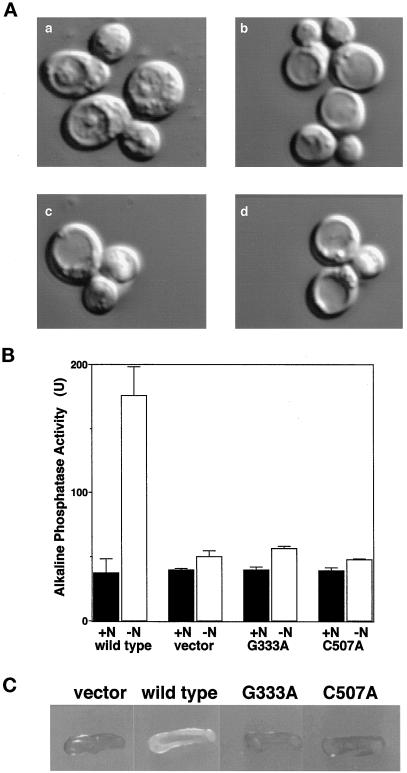Figure 5.
The ATP-binding domain and active site cysteine of Apg7p are essential for autophagy. (A) Gly333 and Cys507 in Apg7p are essential for the accumulation of autophagic bodies under nitrogen-starvation conditions. Cells grown to early-logarithmic phase in MVD+Ura medium were transferred to nitrogen-starvation medium in the presence of PMSF and incubated for 8 h at 30°C. Representative Nomarski images of the cells are shown. Autophagic bodies accumulated in vacuoles of apg7Δ cells carrying pAPG7myc-314 (a). Few autophagic bodies accumulated in vacuoles of apg7Δ cells carrying pRS314 (b), pAPG7G333Amyc-314 (c), and pAPG7C507Amyc-314 (d). (B) Autophagy in apg7Δ cells expressing Apg7pG333A and Apg7pC507A was monitored by an alkaline phosphatase processing assay. We constructed strain YTS2 (pho8::pho8Δ60 apg7::HIS3 trp1) and transformed it with plasmids pRS314 (vector), pAPG7myc-314 (wild type), pAPG7G333Amyc-314 (G333A), and pAPG7C507Amyc-314 (C507A). Cells growing logarithmically in MVD+Ade+Ura medium (N+) were transferred to nitrogen-starvation medium and incubated for 4 h at30°C (N−). Alkaline phosphatase activity in cells under rich or nitrogen-starvation conditions was measured as described by Noda et al. (1998). (C) Gly333 and Cys507 in Apg7p are essential for cell viability under nitrogen-starvation conditions. Cells were plated on nitrogen-starvation medium containing 10 μg/ml phloxine B and incubated at 30°C for 3 d. Nonviable cells were stained red (gray in monochrome), whereas viable cells were not stained (white in monochrome).

